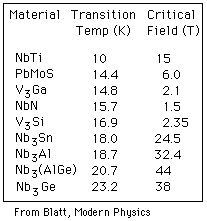|
The thirty pure metals listed at right are called Type I
superconductors. The identifying characteristics are zero electrical
resistivity below a critical
temperature, zero internal magnetic field (Meissner
effect), and a critical
magnetic field above which superconductivity ceases.
The superconductivity in Type I superconductors is modeled well
by the BCS
theory which relies upon electron pairs coupled by lattice
vibration interactions. Remarkably, the best conductors at room
temperature (gold, silver, and copper) do not become superconducting
at all. They have the smallest lattice vibrations, so their behavior
correlates well with the BCS Theory.
While instructive for understanding superconductivity, the Type I
superconductors have been of limited practical usefulness because
the critical magnetic fields are so small and the superconducting
state disappears suddenly at that temperature. Type I
superconductors are sometimes called "soft" superconductors while
the Type
II are "hard", maintaining the superconducting state to higher
temperatures and magnetic fields.
|
| Mat. |
Tc |
| Be |
0 |
| Rh |
0 |
| W |
0.015 |
| Ir |
0.1 |
| Lu |
0.1 |
| Hf |
0.1 |
| Ru |
0.5 |
| Os |
0.7 |
| Mo |
0.92 |
| Zr |
0.546 |
| Cd |
0.56 |
| U |
0.2 |
| Ti |
0.39 |
| Zn |
0.85 |
| Ga |
1.083 | |
| Mat. |
Tc |
| Gd |
1.1 |
| Al |
1.2 |
| Pa |
1.4 |
| Th |
1.4 |
| Re |
1.4 |
| Tl |
2.39 |
| In |
3.408 |
| Sn |
3.722 |
| Hg |
4.153 |
| Ta |
4.47 |
| V |
5.38 |
| La |
6.00 |
| Pb |
7.193 |
| Tc |
7.77 |
| Nb |
9.46 | |
